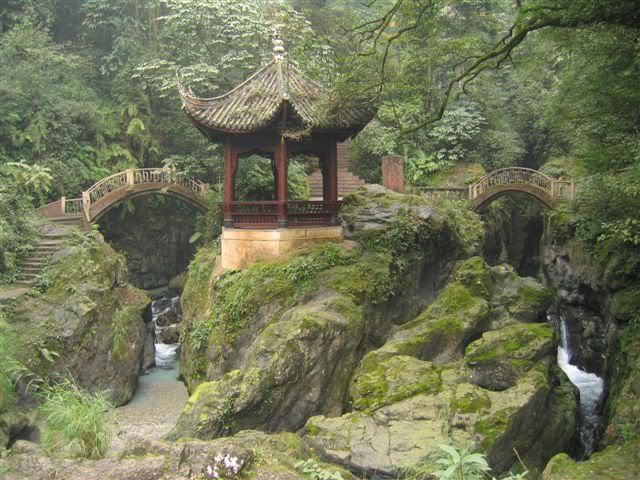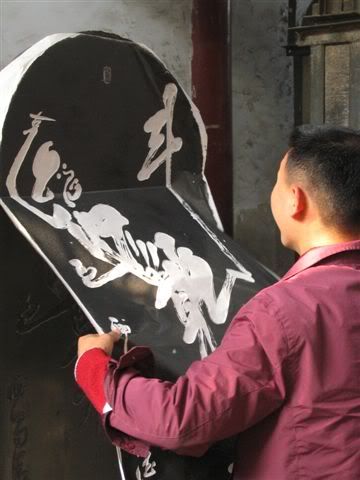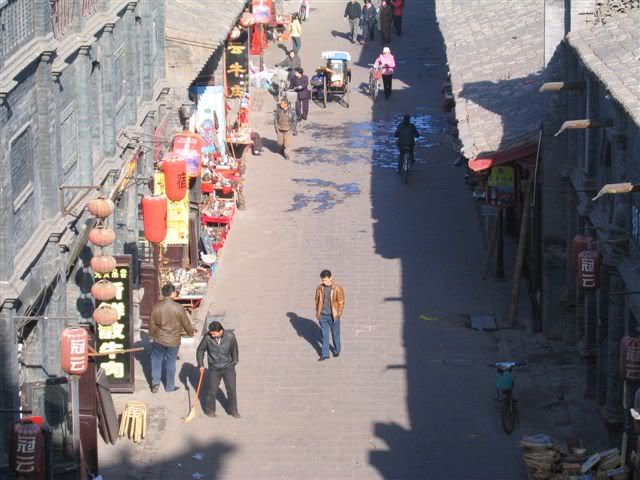Tuesday, November 30, 2004
Leshan & Emei Shan
After more than a week in Chengdu, we needed some fresh air. So we went to
Emei Shan, a sacred buddhist mountain south of Chengdu.
On our way, we did a short stop in Leshan to admire the famous Dafo, a 71
meters high Buddha carved in a mountain. The 1300 year old statue is touted
as the biggest buddhist sculpture in the world.

The next day, we went for a 2 days trek on Emei Shan, staying overnight in
a monastery on the way. Like on all sacred mountains, the trails were paved
and it took thousands of stairs to reach the summit.

Once again, we hit the off-season period, so there was hardly anyone on the
trails. The mist gave the place a chinese ink painting atmosphere.

Nearing the peaks, it got miraculously clear and we could enjoy a beautiful
view over the sea of fog.

...communicating with monks at the summit:

Emei Shan, a sacred buddhist mountain south of Chengdu.
On our way, we did a short stop in Leshan to admire the famous Dafo, a 71
meters high Buddha carved in a mountain. The 1300 year old statue is touted
as the biggest buddhist sculpture in the world.

The next day, we went for a 2 days trek on Emei Shan, staying overnight in
a monastery on the way. Like on all sacred mountains, the trails were paved
and it took thousands of stairs to reach the summit.

Once again, we hit the off-season period, so there was hardly anyone on the
trails. The mist gave the place a chinese ink painting atmosphere.

Nearing the peaks, it got miraculously clear and we could enjoy a beautiful
view over the sea of fog.

...communicating with monks at the summit:

Sunday, November 21, 2004
Chengdu
Another big city: Chengdu, capital of the Sichuan province and a population of 12 millions...
Here, modernisation has left little of the traditional hutongs and their tea-houses. They might even soon completely dissapear. In terms of sights, there is not much in Chengdu: some parks, a fake Quing style shopping street, a statue of Mao Zedong.

What makes the city interesting is the lifestyle of its citizens, which don't seem too bothered by the changes. They continue sipping tea in the sun, playing mahjong. We liked it so much that we stayed 9 days...
We first went to the wooden Wenshu temple to enjoy this relaxed atmosphere.

Then we went to spectacles. A touristy one (but nevertheless good), with samples of Sichuan opera, shadow play, choregraphies, puppets shows...

...the other completely untouristic: the screeching Buenavista Social Club of Sichuan opera. A very touching and memorable experience!

Outside the retirees' club, we met Cheng, a chinese guy. We got together a couple of times in a teahouse on one of the last popular hutongs, where he helped us to learn mahjong and go.

He also introduced us to the local hotpot culture. Once we got used to the special ingredients (duck intestines, blood, feet, pig trotters, lamb brains, beef stomach, chicken stomach...), we quite liked it! The strong medicinal liquor surely lend us some courage to tackle the situation...

A part from the hotpot, Sichuan also has a very refined and varied cuisine which is different from the rest of China. Textures are quite unique, and the local pepper (hot!) more subtle than the first impression. A good reason to extend one's stay in the city.
There was also a national liquor fair in town. We visited the event with our friends to taste chinese wines and spirits, and got photographed by friendly exhibitors in their stands (for publicity?). Anyway, we ended the tour with some gifts...

In an other register, we highly recommend the Panda Rehabilitation Centre on the outskirts, which offers serious information on the cute animal and its habitat. The animals are well kept and have enough space to move and play.

Finally, we made a trip to Dujiangyang to see the 2000 year old water regulation system (a UNESCO World Heritage Site). A bit dissapointing. Basically a river split in two surrounded by a park with concrete temples. And there are ugly concrete dams upflow...
Here, modernisation has left little of the traditional hutongs and their tea-houses. They might even soon completely dissapear. In terms of sights, there is not much in Chengdu: some parks, a fake Quing style shopping street, a statue of Mao Zedong.

What makes the city interesting is the lifestyle of its citizens, which don't seem too bothered by the changes. They continue sipping tea in the sun, playing mahjong. We liked it so much that we stayed 9 days...
We first went to the wooden Wenshu temple to enjoy this relaxed atmosphere.

Then we went to spectacles. A touristy one (but nevertheless good), with samples of Sichuan opera, shadow play, choregraphies, puppets shows...

...the other completely untouristic: the screeching Buenavista Social Club of Sichuan opera. A very touching and memorable experience!

Outside the retirees' club, we met Cheng, a chinese guy. We got together a couple of times in a teahouse on one of the last popular hutongs, where he helped us to learn mahjong and go.

He also introduced us to the local hotpot culture. Once we got used to the special ingredients (duck intestines, blood, feet, pig trotters, lamb brains, beef stomach, chicken stomach...), we quite liked it! The strong medicinal liquor surely lend us some courage to tackle the situation...

A part from the hotpot, Sichuan also has a very refined and varied cuisine which is different from the rest of China. Textures are quite unique, and the local pepper (hot!) more subtle than the first impression. A good reason to extend one's stay in the city.
There was also a national liquor fair in town. We visited the event with our friends to taste chinese wines and spirits, and got photographed by friendly exhibitors in their stands (for publicity?). Anyway, we ended the tour with some gifts...

In an other register, we highly recommend the Panda Rehabilitation Centre on the outskirts, which offers serious information on the cute animal and its habitat. The animals are well kept and have enough space to move and play.

Finally, we made a trip to Dujiangyang to see the 2000 year old water regulation system (a UNESCO World Heritage Site). A bit dissapointing. Basically a river split in two surrounded by a park with concrete temples. And there are ugly concrete dams upflow...
Tuesday, November 16, 2004
Xi'An
Xi'An, besides being the booming capital of Shaanxi, is a city full of history.
The city grid is oriented after the cardinal point and the center is enclosed
by walls. The same disposition as in Pingyao, except Xi'An is about 100 times
bigger and modern high rise buildings took over the scenery.


The terracota army, rediscovered in 1974 by a peasant drilling a well, is
certainly the most famous sight in the Xi'An area. The soldiers are supposed
to guard the tomb of emperor Qin Shi Huang who reunified China and standardised
the writing and measure units in the 3rd century BC. Unfortunately, the army
was badly damaged by fire and collapse of the pits in which there were buried.
But big efforts were done in restauration and the displays gives a good idea
of its past splendor.

There is also very much to see in the city itself. But, as it was getting
cold, we only stayed 5 days there and had to be very selective.
The Beilin museum with its thousands of steles composing an archive of chinese
history and literature fetching back nearly 2000 years, the local shadow
puppet exhibition and the imposing Han Dynasty stone carvings, is one of
our personal highlights. At the back of the museum, prints are directly taken
from the steles, in the traditional way. And the surrounding streets are
packed with calligraphy shops and exhibits, pleasantly extending the visit
to the museum.

We also enjoyed the particuliar atmosphere of the lively muslim quarter,
with it's bazaar and food stalls. Oriental chants come out of the mosque,
which is the center of life for the 30'000 people of Xi'An's Hui minority.
The mosque looks very unusual, like a traditional chinese buddhist temple
with coranic verses written in arabic over the pillars and gates.

Hua Shan
This taoist sacred mountain, a 100km away from Xi'An, makes a good day-trip
to escape the smog and enjoy a piece of blue sky. We got to the park gates
by public bus. From there, a minibus takes most tourists to a cablecar 7
km away. The cablecar arrives below the north peak. To do all 6 peaks in
a day, this is the best option.

The peaks are supposed to represent a flower. The trails are mostly paved,
and can get very narrow at some places. As one could expect, the area near
the end station of the cablecar was quite crowded, but the rest was OK. Eventhough
the peaks are not so high (around 2200 m), the scenery is very impressive.
At some places, the cliffs are 1000 meters high.
The city grid is oriented after the cardinal point and the center is enclosed
by walls. The same disposition as in Pingyao, except Xi'An is about 100 times
bigger and modern high rise buildings took over the scenery.


The terracota army, rediscovered in 1974 by a peasant drilling a well, is
certainly the most famous sight in the Xi'An area. The soldiers are supposed
to guard the tomb of emperor Qin Shi Huang who reunified China and standardised
the writing and measure units in the 3rd century BC. Unfortunately, the army
was badly damaged by fire and collapse of the pits in which there were buried.
But big efforts were done in restauration and the displays gives a good idea
of its past splendor.

There is also very much to see in the city itself. But, as it was getting
cold, we only stayed 5 days there and had to be very selective.
The Beilin museum with its thousands of steles composing an archive of chinese
history and literature fetching back nearly 2000 years, the local shadow
puppet exhibition and the imposing Han Dynasty stone carvings, is one of
our personal highlights. At the back of the museum, prints are directly taken
from the steles, in the traditional way. And the surrounding streets are
packed with calligraphy shops and exhibits, pleasantly extending the visit
to the museum.

We also enjoyed the particuliar atmosphere of the lively muslim quarter,
with it's bazaar and food stalls. Oriental chants come out of the mosque,
which is the center of life for the 30'000 people of Xi'An's Hui minority.
The mosque looks very unusual, like a traditional chinese buddhist temple
with coranic verses written in arabic over the pillars and gates.

Hua Shan
This taoist sacred mountain, a 100km away from Xi'An, makes a good day-trip
to escape the smog and enjoy a piece of blue sky. We got to the park gates
by public bus. From there, a minibus takes most tourists to a cablecar 7
km away. The cablecar arrives below the north peak. To do all 6 peaks in
a day, this is the best option.

The peaks are supposed to represent a flower. The trails are mostly paved,
and can get very narrow at some places. As one could expect, the area near
the end station of the cablecar was quite crowded, but the rest was OK. Eventhough
the peaks are not so high (around 2200 m), the scenery is very impressive.
At some places, the cliffs are 1000 meters high.
Wednesday, November 10, 2004
Pingyao
Pingyao is a small town in the Shanxi province. Surrounded by Ming-era walls,
the center hasn't changed much since the 19th century, when it was an important
banking center. Nowadays, it's main source of revenue comes from tourism.
There are plenty of quaint guesthouses in renovated courtyard houses with
traditional alcove beds and souvenir shops.

The centre is closed to traffic during the day. And given it's now off-season,
the place is not crowded. The locals outnumber the western tourists by 1000:1
and some souvenir shops are closed, so it's very agreable to walk around.
At night, the streets empty rather early and public lighting is limited
to big red lanterns. Children go home before dark fearing the Ming ghosts
that haunt the streets, and adults burn offerings. We stayed here 5 days,
relaxing and enjoying the special atmosphere.

Finally, we rented rusty bicycles for a journey to the Shuanglin Temple
and around the town.

The temple is 7 km from the old town. Thousands of figurines, some dating
back to Song dynasty (i.e 1000 years old), are arranged in compositions
in 10 halls. The themes range from the life of buddah to the adventures
of some warfaring emperor.

the center hasn't changed much since the 19th century, when it was an important
banking center. Nowadays, it's main source of revenue comes from tourism.
There are plenty of quaint guesthouses in renovated courtyard houses with
traditional alcove beds and souvenir shops.

The centre is closed to traffic during the day. And given it's now off-season,
the place is not crowded. The locals outnumber the western tourists by 1000:1
and some souvenir shops are closed, so it's very agreable to walk around.
At night, the streets empty rather early and public lighting is limited
to big red lanterns. Children go home before dark fearing the Ming ghosts
that haunt the streets, and adults burn offerings. We stayed here 5 days,
relaxing and enjoying the special atmosphere.

Finally, we rented rusty bicycles for a journey to the Shuanglin Temple
and around the town.

The temple is 7 km from the old town. Thousands of figurines, some dating
back to Song dynasty (i.e 1000 years old), are arranged in compositions
in 10 halls. The themes range from the life of buddah to the adventures
of some warfaring emperor.

Tuesday, November 09, 2004
Datong
Datong is an industrial city in the north of the Shanxi province. Our trip there, by day train in the hard seat class, was an amusing experience due to the curiosity of the people and their over-eagerness to recommend us hotels (usually 5 stars) and sights.
Nowadays, Datong is quite an unremarkable place boasting pollution records thanks to it's mining industry and coal power plants which provide Beijing with electricity.

But the surroundings bear two very impressive sites, relics from the times where Datong was the capital of the Northern Wei dynasty, 1500 years ago. The first is the Yungang caves, where buddhist temples and shrines are carved directly in the mountain. The largest statues where approximately 20 meters high.

The second is the hanging temple. This cliff already held a temple during the Wei times. Each time the river washed it away, the monks built a new one a bit higher to avoid it happening again... The actual one is maybe 200 years old, and is rather safe since an electric dam was built upstream.

Nowadays, Datong is quite an unremarkable place boasting pollution records thanks to it's mining industry and coal power plants which provide Beijing with electricity.

But the surroundings bear two very impressive sites, relics from the times where Datong was the capital of the Northern Wei dynasty, 1500 years ago. The first is the Yungang caves, where buddhist temples and shrines are carved directly in the mountain. The largest statues where approximately 20 meters high.

The second is the hanging temple. This cliff already held a temple during the Wei times. Each time the river washed it away, the monks built a new one a bit higher to avoid it happening again... The actual one is maybe 200 years old, and is rather safe since an electric dam was built upstream.

